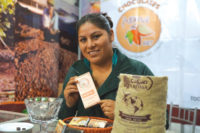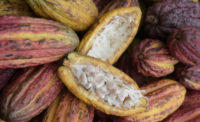
|
| Visitors to the Salon were treated to an array of booths where they could meet everyone from growers to artisans. Photos by Daniel Lorenzetti. |
The mezzanine of the Sheraton Lima erupted into a riot of colorful activity as acrobats, drummers and dancers — many in indigenous Peruvian costume — led a noisy procession into an exhibit hall filled with more than 40 colorful booths overflowing with confections of every kind. Cacao growers and producers mingled with chocolate artisans offering creative seductions to tantalize and inspire.
And so began Peru’s 4th annual Salon del Cacao y Chocolate.
The event is part of an ongoing effort to promote the country's cacao production, while simultaneously discouraging the spread of illicit crops.
Nadine Heredia, Peru’s popular First Lady, greeted the opening day crowd. She noted that Peruvian cacao is considered one of the best in the world, and stressed that the economic importance of cacao to the country could not be overstated.
While praising Peruvians — who have made the transition from illegal crop production to one increasingly known for cacaos — she also recognized the efforts of women in many of the growing regions for their commitment to making that transition possible.
Also on hand was Stephane Bonnet, a sixth-generation chocolatier from Voiron, France to represent the famed Paris Salon du Chocolat. Rose Likins, the United States Ambassador to Peru was also in attendance, as were the Ambassadors from France and Switzerland.
Representatives from US AID were present as as well. The agency provides major financial backing for the event through ongoing programs with partnering organizations. Together they have played an instrumental role in providing educational and technical know-how in bringing crop alternatives to Peruvian farmers. With an emphasis on sustainability, they help to introduce, teach and develop markets for legal crops. It was obvious from looking around the room that there were many success stories to show for their efforts.
Potential cacao buyers from all over the world gathered in the Buyers Room, near the main show floor, to meet with growers and exporters.
The producers represented not only the diversity of growing regions in Peru, but also the growing market worldwide for Peruvian chocolate. And the cacao buyers — from small artisan chocolatiers to major corporations — represented locations as diverse as Oregon, Vancouver, Toronto, Atlanta, France, Baltimore, Switzerland, Spain, Ecuador and China.
During the three-day Salon, there were numerous presentations on topics such as sustainability, competitiveness, exportation, world markets and quality control.
Buyers were often heard stressing a need for quality organic cacao, while growers countered with concerns for guaranteed prices to cover their production costs. El Nina conditions blanketed Lima in cool, dense fog to emphasize the concerns — discussed inside — of worldwide weather change. And, while most of the conference presentations were in Spanish, translation was provided for those who spoke English and French.
Other presentations focused on ways to develop Peruvian consumption of chocolate. Because 90 percent of the country’s cacao is exported, the hope is to not only export more high quality cacao, but to increase domestic use of it as well.
But, back on the main exhibit floor, it seemed as if the problem of domestic consumption had taken on a solution of its own.
For three days, the floor was increasingly crowded with a vibrant array of visitors and attendees sampling domestically grown nibs and beans, while chocolate fountains overflowed, and trays offered samplings of pallets, chocotejas, bombones, barras, mermaladas and licors — confections, jams and liquers of every description. There was even chocolate sushi.
On the raised stage at the front of the room there were ‘chocodemos,’ — continuous presentations from an international parade of chefs and chocolatiers, even a man who claimed to be the fourth strongest in the world. To prove his point, he rolled an omelet pan into what looked like a French crepe. His secret, he confessed, is that he eats 70 percent chocolate at intervals through the day to maintain his strength.
Chocolate confections made with pisco— a grape brandy considered the national beverage of Peru — were everywhere.
Werner Ruegsegger, a chocolatier from Switzerland, demonstrated his process for making such a confection, sampling and adding more pisco until he had achieved the flavor he wanted. He stressed the importance of tasting to achieve just the right balance of flavors.
Stephane Bonnat returned to the stage to make his own pisco inspired creation, combining infused chocolate and tropical fruit. He makes frequent trips to Peru — not only to source cacao, but to teach chocolate-making techniques. He feels strongly that it is important to offer assistance to cacao farmers, many of whom live in remote locations with a lack of transportation, medical facilities and modern communication. His actions speak to the essential connection between those who grow cacao and those who use it to create an end product.
Kristen Hard, from the Atlanta Chocolate Co., demonstrated her popular chocolate salami recipe for the audience. She makes it a point to personally know the people from whom she purchases cacao and has been instrumental in helping form Cocoa of Excellence, dedicated to strengthening the worldwide link between cocoa farmers, cooperatives, estates and research centers in finding fair market and recognition for quality cacao.
The last demonstration was by Sylvie Faucher from Lyon, France. She raised the bar by demonstrating how to make a large, three-dimensional, hollow chocolate heart dusted with gold powder.
Creativity took on another form in a nearby room, which was filled with artistic expressions carved in chocolate.
Popular sci-fi figures were favored, with ominous characters scattered around the room. Other creations used dried cacao pods to make useful things like lamp shades and purses.
Also on hand was the Lima ChocoMuseo. They spent the day putting cacao pods into the hands of both children and adults who had never held one before, and explaining exactly how chocolate is made from something that doesn’t look like chocolate.
With each passing day, the Salon drew larger crowds. By the time it came to a close on Sunday evening, it was obvious that the goal of creating meaningful dialogue — as well as working relationships and friendships between producers, consumers, buyers, master chocolatiers and artisans of all kinds — had been more than achieved.
In every aspect of the Salon, the obvious subject had been chocolate. But at a deeper level, the three-day event was largely about social development and change. It focused on creating economic and social opportunity toward a healthier, more productive way of life for many Peruvians. And with it, the promise of a dynamic future that we can all — no matter which aspect of cocoa or chocolate we engage in — play a vital role.
The Salon del Cacao y Chocolate is held annually. In an effort to control the spread of illicit crops and enable sustainable development, it is sponsored with additional support from the Peruvian Ministers of Agriculture and Production, the National Commission for the Development and Life without Drugs, The Peruvian Association of Cacao and Chocolate (APPCACAO) and the Peruvian Exportation and Tourism Promotion Board (PROMPERU).
Linda Rice Lorenzetti is a correspondent for Candy Industry Magazine. Together with her husband, documentary photographer Daniel Lorenzetti, they are working on a project entitled The Birth of Chocolate (www.birthofchocolate.com)




